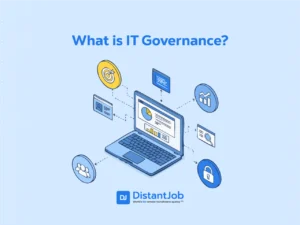Small businesses took on considerable challenges in the past year. Many had to close their doors permanently. Others shifted their operations to online-only platforms. As a result, lead generation and customer retention strategies were forced to evolve as well.
At the beginning of the pandemic and today, many small businesses have had trouble hiring employees to help them rebuild and recover from such a turbulent year. With the sudden shift to remote work and increased reliance on technology, business owners will have to get creative in their recruitment efforts to solve their hiring troubles.
Fortunately, advanced technology and the internet can aid with creative and innovative recruitment methods. In particular, IT recruitment methods can craftily help you in your hiring process and strengthen your team so you can find yourself with the most talented, capable individuals in your industry.
Six IT Recruitment Methods for Your Small Business
Company leaders and HR professionals use various techniques, skills, methods, and processes to accomplish recruitment objectives. Technology has also made the recruitment process more efficient and has helped company leaders land top talent for their businesses. But for smaller businesses, what are their options for achieving the same?
1. Social Media
Social media gave us a tremendous opportunity to connect, communicate, and network with one another. Millions power the individual use of these platforms, but businesses also found their footing on the social media playground. Small business owners use social media every day to connect with their current and potential customers.
You can also use social media as a recruitment method. Recruiting on social media can be incredibly successful if you know your ideal candidate, how they communicate, the platforms they’re engaged on the most, and the type of employee you’re looking for — if you don’t, consider taking time to document those parts of the job internally so that you have a good idea of where to go in your digital recruiting posts. For example, Millennials and Gen Zers are taking over the workforce, and they happen to be major social media users. So, it’s in your business’s best interest to explore how you can better your online presence to ensure you’re reaching these generations.
Small businesses don’t have the marketing and recruiting budgets of a big company. Social media levels the playing field a bit, allowing everyone to build a significant social presence.
Create an ideal candidate profile and begin targeting those that fit this profile via your social media profiles. Create content for your Instagram, Snapchat, Facebook, and Linkedin pages about job openings, company culture, employee recognition, and so forth that would resonate with your target candidate.
2. Mobile Recruitment
Although social media has its benefits when it comes to hiring, it’s constantly changing. People are constantly changing their social media preferences, and may or may not see a job posting you created.
Mobile recruitment, on the other hand, is highly effective. We use our mobile phones every day, all day, for everything. We’re constantly making phone calls, sending text messages, checking our social media, answering emails, engaging with other apps, and so on. Because of that, it was only a matter of time before business owners started exploring how to use mobile devices to their advantage.
Mobile devices significantly impacted customer relationships through text message marketing. Mobile devices have also influenced the way companies can connect with potential employees. Many businesses have taken advantage of mobile recruitment by sending interview reminders, video interview links, follow-up messages, and other necessary job-related information via text.
As a business, it’s necessary for today’s digital age to utilize these mobile recruitment strategies among others. Take an in-depth look at how you can connect with ideal candidates on their mobile devices. You should also ensure that any applications, skills tests, and web pages are optimized for mobile devices.
3. Digital Ads
Of all the IT recruitment strategies you’ll utilize, ads will most likely be the most common instigator for prospects to apply. Ads are everywhere. We’ve all seen ads that seem like they’re presented to us on the right platforms, at the right time, and with the right message. Whether it’s to offer products that could help us, services that we’d be interested in, or events we may be drawn to, businesses are taking full advantage of digital ads.
Digital ads can also be used in the hiring process. Many companies still stick to job boards like Craigslist or search engines like Monster or Indeed to post vacant positions. They also see productive results from posting job advertisements on social media platforms and general search engines. Digital ads are popular among small business owners because they can be tailored to fit your budget. Small business advertising in the digital marketplace allows you to test ads, timing, messaging, platforms and a lot more for a lot less.
Choose 1-3 digital platforms used most by your ideal candidate. Launch an ad campaign for vacant positions on these platforms. Experiment with different wording and CTAs in each of your ads. Use ad builder tools to ensure you’re targeting efficiently and able to track your ad’s productivity.
4. Applicant Tracking System
It can be difficult to track every single applicant, even the ones that stand out. Most companies have a system to track applicants and keep their information organized when it’s time to reach out. Although small businesses may get by with a “pen and paper” system for keeping track of their applicants, their recruitment methods won’t be as effective without an applicant tracking system.
According to Jobscan, “an applicant tracking system (ATS) is a human resources software that acts as a database for job applicants.”
It can filter candidate resumes based on the skills your business needs. For example, suppose you want someone with computer science knowledge. In that case, you should apply filters to your APS system for hard and soft skills like programming and coding language, software development, technical writing, creativity, communication, and detail-oriented.
You should implement an affordable ATS system to save time carefully analyzing the hundreds of online resumes you receive. It can also make hiring for multiple positions at once a feasible process for the one-person recruiting show in most small businesses.
5. Video Interviewing
With all the extra miles small businesses have had to go to hire new people during this pandemic, there doesn’t seem to be many positives from this past year. However, some businesses have found the positives in the growth they’ve seen internally. When stay-at-home orders were enforced, business owners had to find a way to continue interviewing candidates and bringing them on board.
Video interviewing and virtual onboarding experiences were created and continue to be go-to methods as things open back up. Video interviewing opens up your candidate pool and allows you to connect with candidates who live abroad. It also allows you to prescreen applicants by getting video responses to preliminary questions.
A virtual onboarding experience can provide candidates with a virtual tour of your business, an interactive walkthrough of your employee handbook, and a reenactment of a day in the life of someone in the position.
Ensure that you’re set up for video interviewing with budget-friendly apps like Zoom, Google Hangout, and Skype. You can then explore purchasing VR headsets and viewers to incorporate virtual experiences in your recruiting methods.
6. Artificial intelligence and automation
Another positive aspect of the hiring process that the pandemic has spurred on is automation. Although there’s an ongoing debate about robots and machines taking over our jobs and world, you can rest assured that artificial intelligence and automation are nothing without a human touch. Artificial intelligence can mimic human behavior and think in certain aspects of recruiting. Automation can also increase the efficiency of your recruitment methods by putting repetitive tasks on auto-pilot.
Small businesses can use AI and automation for:
- AI-driven writing tool for digital ads
- Collecting and analyzing applicant data
- Candidate matching
- Resume screening
- Sourcing
- Chatbots
Do an audit of your finances before buying AI software or automation tools. You want to ensure you can afford quality software and tools and training to use them efficiently. You also want to be highly familiar with your ideal candidate so that you can collect accurate data that streamline your recruitment process. Identify what practices you can automate and where you can integrate AI.
Final IT Recruitment Method: DistantJob
Recruiting in the most efficient, productive way is crucial to building a powerful team. Advancing technology has given companies more of an opportunity to land top talent in their industries. However, hiring IT talent is not only about having the right technology but also about having efficient processes and strategies.
If you’re struggling to scale your company with the talent you need, contact us! At DistantJob, we’re the leading tech remote recruitment agency, and we focus on giving our clients highly specialized full-time remote employees.





